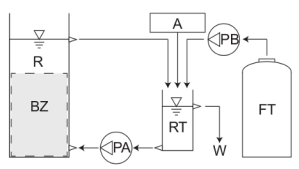High Density Bioreactor (HDBR)
The novel architecture/arrangement of the High Density Bioreactor (HDBR) allows researchers to grow very high density microbical cultures. Thus far the HDBR system has been used to successfully grow and study a wide variety of mixed community cultures:
- Algae and cyanobacteria
- Simultaneous nitrification and denitrification
- Heterotrophic bacteria within activated sludge
- Fermentation with yeast

Schematic of a High Density Bioreactor (HDBR) (not to scale). The Reactor (R) is composed of a 1,000 ml graduated cylinder. Reactor fluid is cycled through the reactor using peristaltic Pump A (PA), entering at the bottom of the reactor and flowing upwards through the biomass zone (BZ) towards the top port. Fluid exits the reactor at the top port and is directed to the recycle tank (RT) under gravity. Reactor fluid is returned to the reactor via the bottom port (and PA). Effluent leaves the reactor via the top port of the RT and is collected in a Waste container (W). Diffusive aeration is provided in the RT with the use of an aerator (A). The aeration process also drives mixing within the MV. Peristaltic Pump B (PB) delivers influent from a tank containing feed/influent (FT) into the RT. [Figure and caption adapted from Price et. al. 2015]
If you’d like to learn more about the HDBR, please review Price et. al. 2015 and Price et. al. 2016 on my publications page.
My research with the HDBR has focused primarily on studying algae and algal-based microbial communities. For more information on my algae research, vist the algae page here.
News and press-related items:
- Read and listen to Algae could be an unlikely helper for cleaning wastewater, a segment on the radio program The Pulse.
- View Cleaning Wastewater with Pond Scum in the Science and Technology Section of Drexel Now.
- View Pond scum research is clearing the waters in The Triangle.
- View Researchers turn to algae for waste treatment in Water Online.
